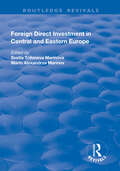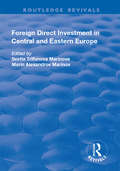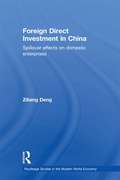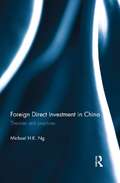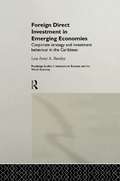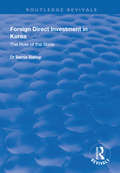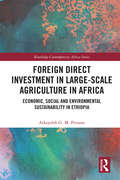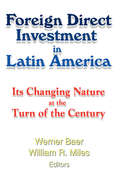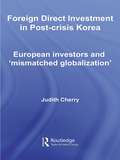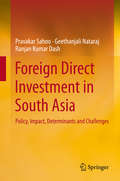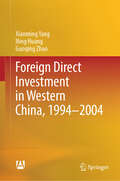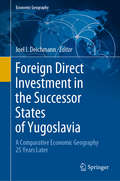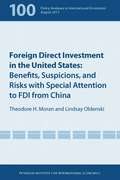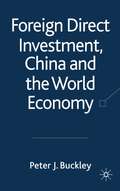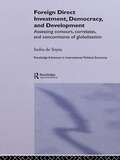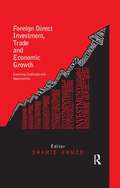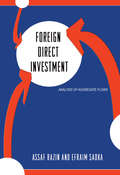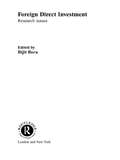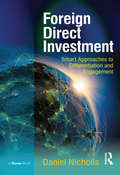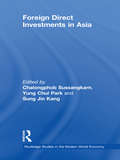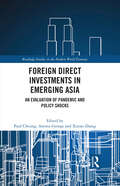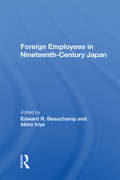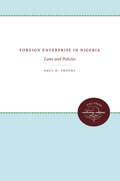- Table View
- List View
Foreign Direct Investment in Central and Eastern Europe (Routledge Revivals)
by Marin Alexandrov Marinov Svetla Trifonova MarinovaThis title was first published in 2003. Covering a diverse range of countries such as Bulgaria, the Czech Republic, Hungary, Poland, Slovakia, Slovenia and Russia, as well as referring to the characteristics of the region as a whole, this book examines the inflow and outflow of foreign direct investment from both home and host company and country perspectives. By analyzing foreign direct investment in terms of process, content and context, the book provides a holist approach towards direct foreign investment in the transitional context of Central and Eastern Europe, embracing both macro- and micro-economic perspectives of the process.
Foreign Direct Investment in Central and Eastern Europe (Transition And Development Ser.)
by SVETLA TRIFONOVA MARINOVA AND MARIN ALEXANDROV MARINOVThis title was first published in 2003. Covering a diverse range of countries such as Bulgaria, the Czech Republic, Hungary, Poland, Slovakia, Slovenia and Russia, as well as referring to the characteristics of the region as a whole, this book examines the inflow and outflow of foreign direct investment from both home and host company and country perspectives. By analyzing foreign direct investment in terms of process, content and context, the book provides a holist approach towards direct foreign investment in the transitional context of Central and Eastern Europe, embracing both macro- and micro-economic perspectives of the process.
Foreign Direct Investment in China: Spillover Effects on Domestic Enterprises (Routledge Studies in the Modern World Economy)
by Ziliang DengThis book provides an insightful exploration of whether foreign direct investment (FDI) can promote the productivity of domestic enterprises. The book is based on a series of dedicated research conducted in the context of the Chinese economy, which has been the largest FDI host among the developing economies since 1993. The main themes of this book are (a) based on the latest literature and first-hand research, outlining possible mechanisms through which foreign direct investment could promote the productivity of domestic enterprises; (b) developing a comprehensive research framework to quantify the spillover effects with cutting-edge methodology; (c) constructing a decision support system for evaluating FDI policy reforms with advanced computer simulation techniques; (d) evaluating the broader impact of FDI spillovers on banking system and trade pattern. The book examines topical economic issues in the contemporary world economy from innovative perspectives, namely, how the presence of multinational enterprises has been one of the most important microeconomic drivers for the Chinese economy, how foreign banks have helped to enable Chinese banking system survive the global financial crisis, and how the domestic enterprises have learned to do exports from multinational affiliates and have changed the landscape of U.S.-Asian trade. The book incorporates the latest development of economic theory as well as computational economics model.
Foreign Direct Investment in China: Theories and Practices
by Michael H. NgForeign direct investment has contributed significantly in transforming the Chinese economy over the past three decades. China has become one of the most popular destinations for foreign direct investment. For corporations and business executives who desire to participate in the expanding China market, understanding correctly the driving forces and impacts of foreign direct investment in China, as well as the ways to smartly execute investment transactions there has become the fundamental knowledge that they need to grasp. This book is a combination of the author’s research and 15-year practical experience in managing investment transactions in China. This book uniquely offers both a theoretical overview of the phenomenon of FDI in China (chapters two to four) as well as the practical steps in executing investment transactions there (chapters five to seven). The author also provides illustrative charts and tables, literature summaries, transaction templates based on case studies from his real-life experience on the ground. This is so far the only book on FDI in China which covers both the theoretical perspectives as well as practical advices in investments. This book serves not only as a useful resource for students, teachers and policy makers who are interested in both theoretical and practical aspects of FDI in China, but also a valuable guidebook for business development executives, investment professionals and transaction lawyers who are involved in direct investment deals in China on a daily basis.
Foreign Direct Investment in Emerging Economies: Corporate Strategy and Investment Behaviour in the Caribbean (Routledge Studies in International Business and the World Economy)
by Lou Anne BarclayThe Caribbean countries of Jamaica, Barbados and Trinidad-Tobago represent excellent examples of the increasingly important role played by Foreign Direct Investment (FDI) in less developed, micro-economies. The increased dependence of these countries on FDI, however, calls into question the attractiveness of the business environment of the region to the foreign investor. This volume examines both the investment behaviour and corporate strategies operating in these three countries, and assesses the factors which influence the motivations, location choices and market entry mode of multinationals making investments in the Caribbean.
Foreign Direct Investment in Korea: The Role of the State (Routledge Revivals)
by Bernie BishopPublished in 1997, this book traces the history of foreign investment policy in South Korea from 1961 until the present. It shows how Korea adopted a highly successful interventionist strategy towards foreign direct investment channeling it into areas of the economy where it could achieve the most benefit for the country’s economic development. In recent years Korea has tried to adopt a more market driven approach. However, differences within various institutions within the public and private sector led to policy confusion and ineffectiveness in meeting policy goals. The conclusion reached is that moving from an interventionist strategy to a market orientated strategy is difficult in this policy area. The book breaks new ground because it shows that while the conventional wisdom is that a 'market economy' approach is beneficial, moving from an interventionist policy to a market-orientated one is problematic and cannot be accomplished quickly.
Foreign Direct Investment in Large-Scale Agriculture in Africa: Economic, Social and Environmental Sustainability in Ethiopia (Routledge Contemporary Africa)
by Atkeyelsh G. PerssonThis book examines environmental sustainability and inclusive economic growth, providing in-depth analysis of foreign direct investment (FDI) in large-scale agriculture in Ethiopia. In most African states, arable land and other natural resources play a pivotal role for economic growth and development. Ethiopia is one of those countries where agriculture is the backbone of the economy. This sector has also been an attraction for FDI in Sub-Saharan Africa since the global food and financial crisis of 2007 and 2008. This book uses six foreign investments in large-scale agriculture as case studies to examine current Ethiopian policies, the patterns of investment they promote, how these impact on land-based resources and communities’ wellbeing. Presenting analyses of the economic, social and political realities of foreign direct investment in the local context, Foreign Direct Investment in Large-Scale Agriculture in Africa discusses how the fundamental principles of pro-poor and environmentally sustainable investments intersect with the government’s ambition to advance Ethiopia’s development agenda. This book will be of interest to scholars and students of African economics and sustainable development, African policy makers, intergovernmental organisations as well as multilateral and bilateral development partners.
Foreign Direct Investment in Latin America: Its Changing Nature at the Turn of the Century
by Werner Baer William MilesExamine the changing nature of foreign investments in Latin America!Generously enhanced with easy-to-understand charts, tables, and graphs, this book covers the ins and outs of foreign direct investment in the established and emerging markets of Latin America. In addition to an overview of direct investment for the entire Latin American region in the 1990s, this valuable book examines specific countries&’ experiences with FDI in that decade. These include Argentina, Chile, Mexico, Brazil, Peru, Ecuador, Paraguay, Costa Rica, El Salvador, Guatemala, Honduras, and Nicaragua.Spending on environmental projects is on the rise, and Latin American nations are at the forefront of this financial whirlwind in the developing world. Foreign Direct Investment in Latin America: Its Changing Nature at the Turn of the Century examines the difficulties of assessing environmental investments. It analyzes the role of international capital in Latin-American environmental issues and discusses the major players, such as the World Bank, in international capital and the environment.Foreign Direct Investment in Latin America presents case studies that illustrate: the history of FDI in Argentina and the impact of the privatization of state-owned enterprises in 1991-1993 the similarities and differences between 1990s FDI in Mexico and Chile the ways that modern investment in Brazil differs in purpose from investment there in previous economic eras how Peru addressed its balance-of-payments crisis in a time when its domestic financial markets were thin and there existed few sources of financing besides banks how Paraguay&’s historical lack of infrastructure has hampered FDI efforts there Ecuador&’s financial and balance-of-payments crisis-its currency is in free-fall and its financial institutions are on the brink of collapse . . . and much more!Foreign Direct Investment in Latin America packs all this valuable information into a single user-friendly source. As we move into the new millennium, no student, educator, or investor interested in this quickly evolving, volatile market should be without it!
Foreign Direct Investment in Post-Crisis Korea: European Investors and 'Mismatched Globalization' (Routledge Advances in Korean Studies)
by Judith CherryIn this book Judith Cherry analyses the impact of economic and cultural globalization on efforts to promote inward foreign direct investment (IFDI) in South Korea over the past four decades. The book traces the development of Korean IFDI policy from one of restriction and control to one of encouragement and promotion. Specifically, it focuses on the challenges inherent in reforming the ‘software’ of IFDI promotion (socio-cultural issues, mindsets and perceptions) as opposed to changing its ‘hardware’ (systems, laws and regulations). Although the Korean government has made sustained efforts over the past decade to enhance Korea’s attractions as a host for inward investment, it has faced significant challenges in improving Korea’s IFDI performance. The discussion in this book of the wide range of transparent and non-transparent barriers that continue to hamper efforts to promote inward investment draws not only on the Korean debate concerning strategies for maximizing the benefits of IFDI, but also on the assessment of the Korean business and investment environment revealed in interviews conducted with European investors and officials in Seoul. Foreign Direct Investment in Post-Crisis Korea will appeal to students and scholars of international business, economics and globalization, as well as those with a more general interest in Korean society.
Foreign Direct Investment in South Asia
by Pravakar Sahoo Geethanjali Nataraj Ranjan Kumar DashDuring the 1990s, the governments of South Asian countries acted as 'facilitators' to attract FDI. As a result, the inflow of FDI increased. However, to become an attractive FDI destination as China, Singapore, or Brazil, South Asia has to improve the local conditions of doing business. This book, based on research that blends theory, empirical evidence, and policy, asks and attempts to answer a few core questions relevant to FDI policy in South Asian countries: Which major reforms have succeeded? What are the factors that influence FDI inflows? What has been the impact of FDI on macroeconomic performance? Which policy priorities/reforms needed to boost FDI are pending? These questions and answers should interest policy makers, academics, and all those interested in FDI in the South Asian region and in India, Pakistan, Bangladesh, Sri Lanka and Pakistan.
Foreign Direct Investment in Western China, 1994–2004
by Xianming Yang Ning Huang Guoqing ZhaoThis book focuses on the FDI in western China and aims to explore the logic behind the regional development. From 1994 to 2004, China’s economy enjoyed a golden stage of rapid growth. As the top destination for foreign investment, China has integrated into the international production system and global value chain. However, it is apparent that the FDI distribution was unbalanced, as the eastern region absorbed far more FDI than its western counterpart, a situation that remained unchanged even after China launched the Western Development Strategy (WDS). This book begins with the question of why it is difficult to introduce FDI to western China, followed by discussion on the gap of technology, human capital, industrial foundation, location selection, institutional factors and investment environment between the western and eastern China. The author analyzes how the lack of FDI growth affects the long-term growth of the western region.
Foreign Direct Investment in the Successor States of Yugoslavia: A Comparative Economic Geography 25 Years Later (Economic Geography)
by Joel I. DeichmannThis edited volume offers a descriptive analysis of foreign direct investment (FDI) flows and cumulative stock, industrial composition, and important spatial trends for each successor state of former Yugoslavia: Bosnia & Herzegovina, Croatia, Kosovo, Montenegro, North Macedonia, Serbia, and Slovenia. The chapters are written by academic experts on the topic from each of these countries and are organised systematically in order to facilitate comparison between the states. The aim of this book is to advance scholarly knowledge about FDI in Southeastern Europe 25 years after the dissolution of Yugoslavia. Each chapter includes a summary of scholarly contributions published on the topic in English-language and local language journals, a discussion of origins, composition by industry, and location choice within the country from 1995-2018, using Dunning's (1980) eclectic paradigm as a discussion framework. The chapters conclude with prospects for FDI over the next twenty-five years with emphasis on economic growth projections, EU integration, and other relevant country-specific considerations the local authors deem relevant. Special attention is given to specific companies operating in Yugoslavia prior to its breakup and how these firms have been impacted by dissolution, recession, efforts toward European Union membership. The authors also examine the past and potential impact of FDI from unforeseen events such as the Global Financial Crisis and COVID-19. This book appeals to scholars of geography, international business, economics, and economic history of the former Yugoslavia as well as professionals working in the region and on related topics elsewhere.
Foreign Direct Investment in the United States: Benefits, Suspicions, and Risks with Special Attention to FDI from China
by Theodore Moran Lindsay OldenskiAmericans have long been ambivalent toward foreign direct investment in the United States. Foreign multinational corporations may be a source of capital, technology, and jobs. But what are the implications for US workers, firms, communities, and consumers as the United States remains the most popular destination for foreign multinational investment?Theodore H. Moran and Lindsay Oldenski find that foreign multinational firms that invest in the United States are, alongside US-headquartered American multinationals, the most productive and highest-paying segment of the US economy. These firms conduct more research and development, provide more value added to US domestic inputs, and export more goods and services than other firms in the US economy. The superior technology and management techniques they employ spill over horizontally and vertically to improve the performance of local firms and workers. As the United States wants not only to expand employment but also create well-paying jobs that reverse the falling earnings that many US workers and middle class families have suffered in recent decades, it is more important than ever to enhance the United States as a destination for multinational investors.
Foreign Direct Investment in the United States: Benefits, Suspicions, and Risks with Special Attention to FDI from China (Policy Analyses in International Economics #100)
by Paul Krugman Lindsay Oldenski Theodore Moran Edward GrahamAmericans have long been ambivalent toward foreign direct investment in the United States. Foreign multinational corporations may be a source of capital, technology, and jobs. But what are the implications for US workers, firms, communities, and consumers as the United States remains the most popular destination for foreign multinational investment?Theodore H. Moran and Lindsay Oldenski find that foreign multinational firms that invest in the United States are, alongside US-headquartered American multinationals, the most productive and highest-paying segment of the US economy. These firms conduct more research and development, provide more value added to US domestic inputs, and export more goods and services than other firms in the US economy. The superior technology and management techniques they employ spill over horizontally and vertically to improve the performance of local firms and workers. As the United States wants not only to expand employment but also create well-paying jobs that reverse the falling earnings that many US workers and middle class families have suffered in recent decades, it is more important than ever to enhance the United States as a destination for multinational investors.
Foreign Direct Investment, China and the World Economy
by Peter J. BuckleyAn in-depth study of the international business relationships of China covering both inward and outward foreign direct investment, its impact and related theoretical and policy issues.
Foreign Direct Investment, Democracy and Development: Assessing Contours, Correlates and Concomitants of Globalization (Routledge Advances In International Political Economy Ser. #Vol. 8)
by Indra de SoysaThe effects of globalization on economy and society are highly contested subjects in academic and political arenas. This study brings an empirical perspective to the crucially important arguments that encapsulate the major debates in this area. Using quantitative data, this book addresses the shape and degree of internationalisation by focussing on
Foreign Direct Investment, Trade and Economic Growth: Challenges and Opportunities
by Shahid AhmedThis volume examines the opportunities and challenges in Foreign Direct Investment (FDI) and trade, particularly service trade, for developing and emerging economies in a globalised world. Using comprehensive case studies from India, Pakistan, Bangladesh, Association of Southeast Asian Nations (ASEAN) and other South Asian Association for Regional Cooperation (SAARC) countries, it explores various channels through which trade and FDI affect the process of economic growth and development. In particular, it determines growth trajectories impelled by service trade (such as telecommunications, transport, finance and distribution), where developing countries are playing an increasingly significant role. It also discusses value chains and production networks in the backdrop of the financial crisis of 2008. Combining theoretical and empirical tools, rigorous methodology and latest data, this work will serve as an important resource for formulation of international trade and economic policies in developing countries. It will be of special interest to students, researchers and policy makers dealing with international trade and FDI, and those in economics, commerce, business & management and political science.
Foreign Direct Investment: Analysis of Aggregate Flows
by Efraim Sadka Assaf RazinThe 1990s saw global flows of foreign direct investment increase some sevenfold, spurring economists to explore FDI from a micro- or trade-based perspective. Foreign Direct Investment is one of the first books to analyze the macroeconomics of FDI, treating FDI as a unique form of international capital flow between specific pairs of countries. By examining the determinants of the aggregate flows of FDI at the bilateral, source-host-country level, Assaf Razin and Efraim Sadka present the first systematic global analysis of the singular features of FDI flows. Drawing on a wealth of fresh data, they provide new theoretical models and empirical techniques that illuminate the vital country-pair characteristics that drive these flows. Uniquely, Foreign Direct Investment examines FDI between developed and developing countries, and not just between developed countries. Among many other insights, the book shows that tax competition vis-à-vis FDI need not lead to a "race to the bottom." Foreign Direct Investment is an essential resource for graduate students, academics, and policy professionals.
Foreign Direct Investment: Research Issues (Routledge Studies In International Business And The World Economy Ser. #Vol. 22)
by Bijit BoraForeign Direct Investment examines the different approaches to explaining the growth and distribution of FDI in the world. Pulling together contributions from an array of international experts, this study combines theoretical with empirical work on issues such as computable general equilibrium modelling, trade, intellectual property, environment, l
Foreign Direct Investment: Smart Approaches to Differentiation and Engagement (Ashgate Studies In Philosophy And Theology In Late Antiquity Ser.)
by Daniel NichollsAs the world continues to recover from one of the most dramatic financial crises in a generation, expanding corporations are increasingly, yet cautiously, seeking out international investment opportunities. At the heart of this fragile investment recovery lie trust and confidence. With an unprecedented number of investment promotion agencies and economic development organisations now competing for the attention and business of a more cautious and discerning investor audience, smart approaches to strategic differentiation, communication, engagement and investment services are becoming increasingly critical if these agencies and organisations are to succeed. At the same time, transparent and responsible approaches to investment, coupled with effective, compelling advocacy, are increasingly important to the success of companies’ investment projects. Daniel Nicholls’ Foreign Direct Investment offers an exploration of some of the key trends, issues and practices that are shaping the global FDI landscape. Along the way he provides insight into how economic developers and investors alike can make the most of their opportunities and mitigate reputational and communications challenges that can impede or hinder a successful investment. By presenting perspectives and priorities from both sides, Daniel Nicholls’ book bridges the ’investment gap’ by giving its readers an important insight into what matters to the other side. This book represents a smart investment for anyone involved.
Foreign Direct Investments from Emerging Markets
by Karl P. Sauvant Geraldine Mcallister Wolfgang A. MaschekForeign direct investment from emerging markets is an increasingly important phenomenon; firms from developed countries alone no longer undertake this activity. "Foreign Direct Investment from Emerging Markets "provides the latest scholarship on this subject from eminent contributors from around the world. This volume demonstrates the importance of rigorous analysis to understand the dilemmas, the controversies, the disputes, and the policy issues that need to be considered in connection with this new phenomenon. In the wake of the financial crisis, it is more critical than ever for those involved in FDI research and policy to understand these issues. "
Foreign Direct Investments in Asia (Routledge Studies in the Modern World Economy)
by Sung Jin Kang Yung Chul Park Chalongphob SussangkarnThis book covers nine countries of ASEAN and the East Asian area, including major Asian countries, and compares their respective policies to attract Foreign Direct Investments (FDI). Through comparative study of FDI promotion policies, this book will give policy makers in the area of FDI promotion an overview and comparison of the FDI policies of other countries. In addition, researchers at graduate, post-graduate or professional level will gain from the econometric methodology and detailed definitions of various spillover effects (horizontal and vertical), which will be beneficial to their research. In addition to FDI policy comparison, this book focuses on the various spillover effects of FDI. It separates it into categories: own productivity effects; intra-industry spillover effects; and inter-industry spillover effects (forward and backward linkage effects). While most other studies have only taken econometric tests on own-productivity and intra-industry spillovers, a key advantage to this book is that it also covers the separate effects of inter-industry linkages. Through policy comparison and econometric tests on various spillover effects on economic growth, employment and exports, this book will give policy makers and researchers an innovative and constructive guide to FDI.
Foreign Direct Investments in Emerging Asia: An Evaluation of Pandemic and Policy Shocks (Routledge Studies in the Modern World Economy)
by Paul Cheung Ammu George Xuyao ZhangForeign direct investments (FDI) play an integral role in the growth story of Emerging Asian economies. As an essential source of foreign capital, FDI bolsters the path to economic recovery from recessions, including the one caused by the COVID-19 pandemic. This book is a collection of essays investigating the reconfiguration of FDI flows to the Emerging Asian economies of ASEAN, China and India following the pandemic and FDI policy reforms. This book broadly covers the trends in greenfield FDI flows to Emerging Asia in the context of three pertinent themes. Part I explores the rebalancing effects in global FDI flows after the COVID-19 pandemic, focusing on the experience of Emerging Asian economies. We also evaluate the nature of the pandemic’s impact on existing FDI linkages between China and ASEAN. Part II delves into the implications of a cross-border policy framework such as the Belt and Road Initiative (BRI). In particular, we examine ASEAN trade activity after China's investments through BRI. We further discuss the future of BRI in ASEAN economies amid the emergence of global competitors. Part III of the book zooms in on the effectiveness of domestic FDI policy reforms. We discuss the cases of Indonesia Special Economic Zones and the Make in India initiative. This book is written for scholars, policymakers and industrial practitioners who wish to gain more knowledge on the recent FDI dynamics of Emerging Asia.
Foreign Employees In Nineteenth Century Japan
by Edward R BeauchampThe product of research by US and Japanese scholars, this book is an assessment of the work of individual "yatoi", and their contributions to the rapid development that characterized Meiji Japan (1868-1912).
Foreign Enterprise in Nigeria: Laws and Policies
by Paul O. ProehlThis study of a newly independent and developing country describes the environment the foreign investor may expect to find if he ventures into Nigeria. The emphasis in on the legal system, but the author also examines certain nonlegal factors, such as the 1962-68 Development Plan, education, and manpower, which all condition the investment climate of the country.Originally published 1965.A UNC Press Enduring Edition -- UNC Press Enduring Editions use the latest in digital technology to make available again books from our distinguished backlist that were previously out of print. These editions are published unaltered from the original, and are presented in affordable paperback formats, bringing readers both historical and cultural value.
